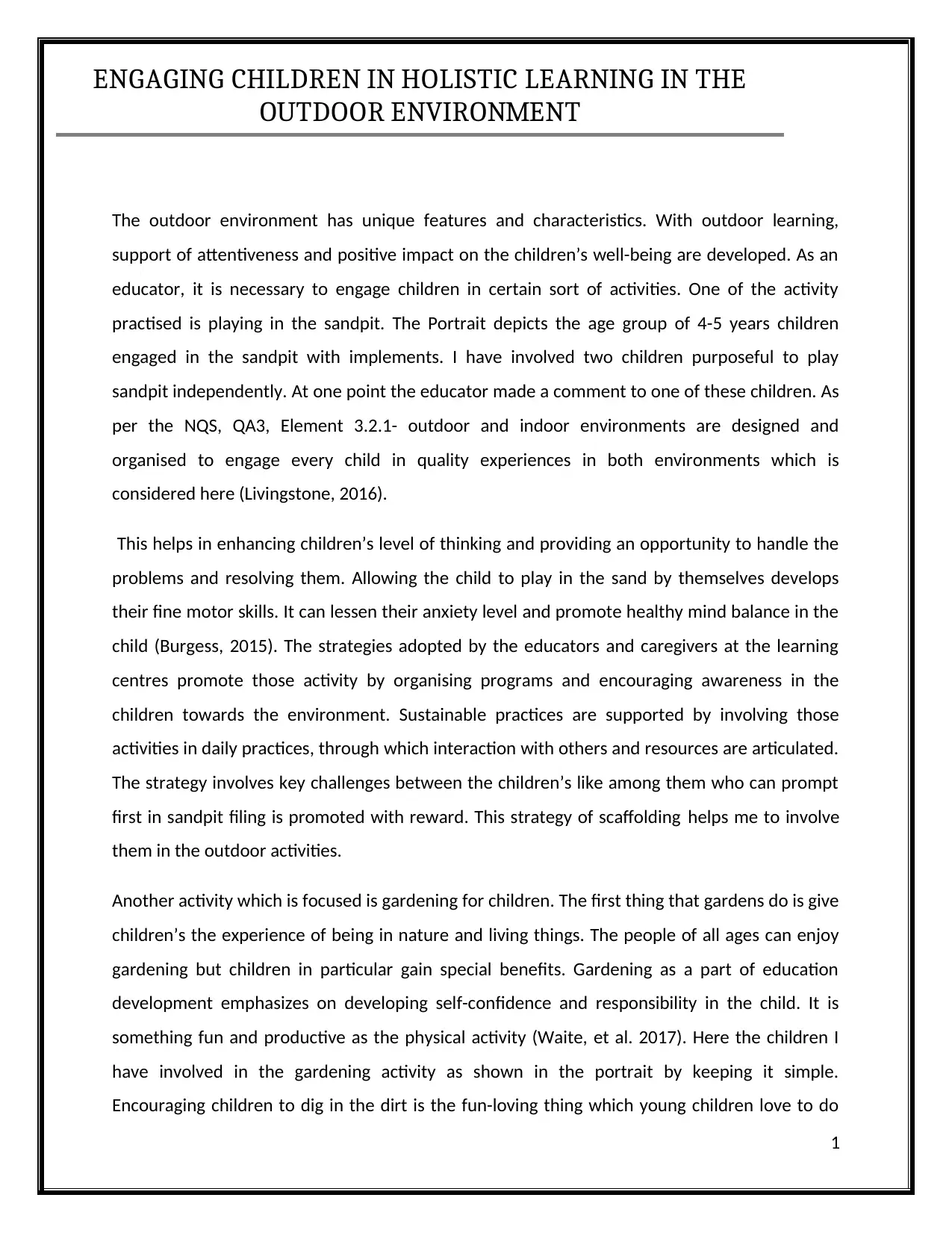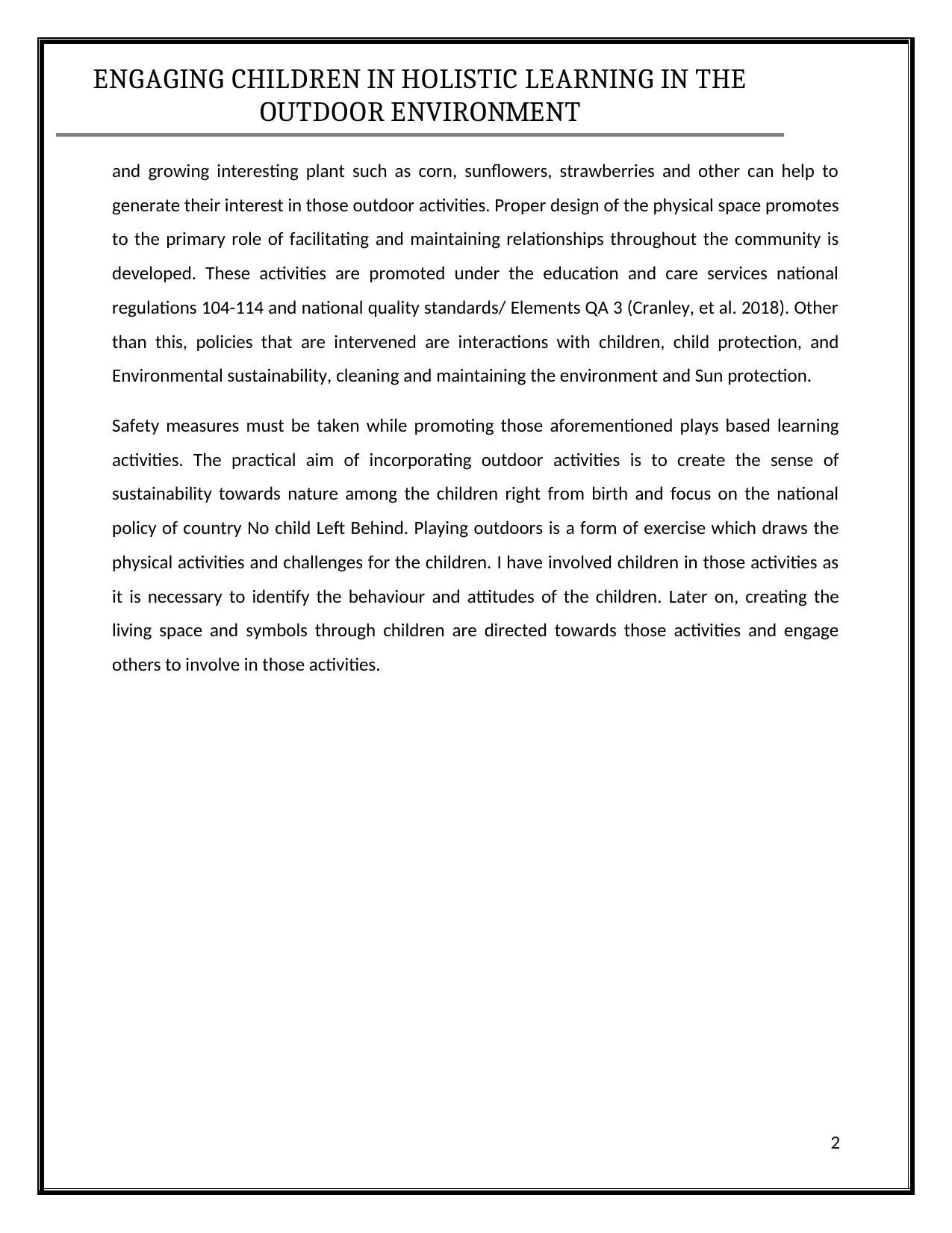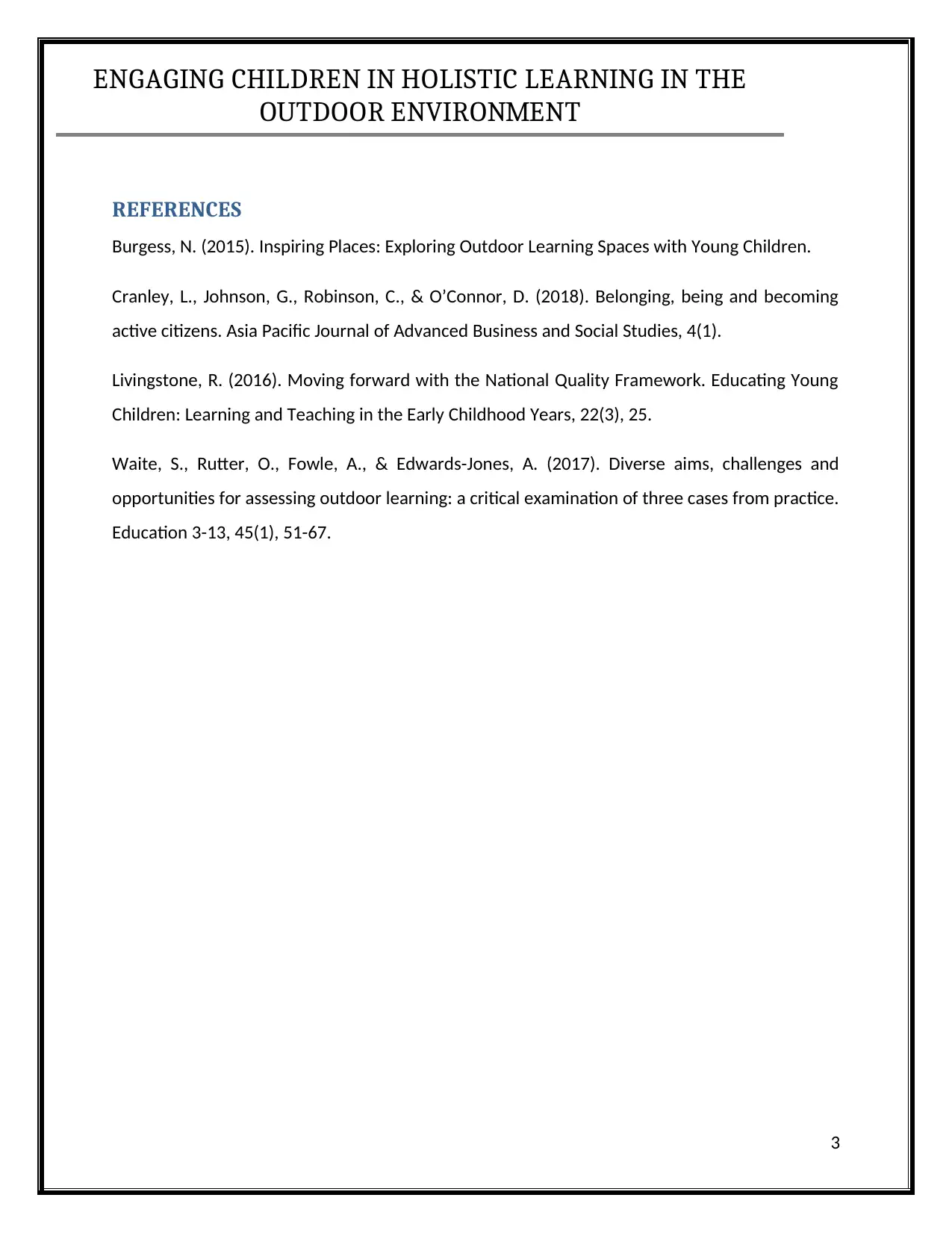Engaging Children in Holistic Learning in Outdoor Environment & NQS
VerifiedAdded on 2024/05/15
|3
|798
|434
Essay
AI Summary
This essay explores methods for engaging children aged 4-5 in holistic learning within outdoor environments, focusing on activities like sandpit play and gardening. It highlights the importance of outdoor learning in developing attentiveness, well-being, and fine motor skills. The essay references the National Quality Standard (NQS) and emphasizes sustainable practices and the role of educators in promoting environmental awareness. Strategies like scaffolding and incorporating fun, engaging activities are discussed. The importance of safety measures and policies related to child protection and environmental sustainability are also addressed, aligning with national policies and aiming to foster a sense of sustainability in children from an early age.

ENGAGING CHILDREN IN HOLISTIC LEARNING IN THE
OUTDOOR ENVIRONMENT
The outdoor environment has unique features and characteristics. With outdoor learning,
support of attentiveness and positive impact on the children’s well-being are developed. As an
educator, it is necessary to engage children in certain sort of activities. One of the activity
practised is playing in the sandpit. The Portrait depicts the age group of 4-5 years children
engaged in the sandpit with implements. I have involved two children purposeful to play
sandpit independently. At one point the educator made a comment to one of these children. As
per the NQS, QA3, Element 3.2.1- outdoor and indoor environments are designed and
organised to engage every child in quality experiences in both environments which is
considered here (Livingstone, 2016).
This helps in enhancing children’s level of thinking and providing an opportunity to handle the
problems and resolving them. Allowing the child to play in the sand by themselves develops
their fine motor skills. It can lessen their anxiety level and promote healthy mind balance in the
child (Burgess, 2015). The strategies adopted by the educators and caregivers at the learning
centres promote those activity by organising programs and encouraging awareness in the
children towards the environment. Sustainable practices are supported by involving those
activities in daily practices, through which interaction with others and resources are articulated.
The strategy involves key challenges between the children’s like among them who can prompt
first in sandpit filing is promoted with reward. This strategy of scaffolding helps me to involve
them in the outdoor activities.
Another activity which is focused is gardening for children. The first thing that gardens do is give
children’s the experience of being in nature and living things. The people of all ages can enjoy
gardening but children in particular gain special benefits. Gardening as a part of education
development emphasizes on developing self-confidence and responsibility in the child. It is
something fun and productive as the physical activity (Waite, et al. 2017). Here the children I
have involved in the gardening activity as shown in the portrait by keeping it simple.
Encouraging children to dig in the dirt is the fun-loving thing which young children love to do
1
OUTDOOR ENVIRONMENT
The outdoor environment has unique features and characteristics. With outdoor learning,
support of attentiveness and positive impact on the children’s well-being are developed. As an
educator, it is necessary to engage children in certain sort of activities. One of the activity
practised is playing in the sandpit. The Portrait depicts the age group of 4-5 years children
engaged in the sandpit with implements. I have involved two children purposeful to play
sandpit independently. At one point the educator made a comment to one of these children. As
per the NQS, QA3, Element 3.2.1- outdoor and indoor environments are designed and
organised to engage every child in quality experiences in both environments which is
considered here (Livingstone, 2016).
This helps in enhancing children’s level of thinking and providing an opportunity to handle the
problems and resolving them. Allowing the child to play in the sand by themselves develops
their fine motor skills. It can lessen their anxiety level and promote healthy mind balance in the
child (Burgess, 2015). The strategies adopted by the educators and caregivers at the learning
centres promote those activity by organising programs and encouraging awareness in the
children towards the environment. Sustainable practices are supported by involving those
activities in daily practices, through which interaction with others and resources are articulated.
The strategy involves key challenges between the children’s like among them who can prompt
first in sandpit filing is promoted with reward. This strategy of scaffolding helps me to involve
them in the outdoor activities.
Another activity which is focused is gardening for children. The first thing that gardens do is give
children’s the experience of being in nature and living things. The people of all ages can enjoy
gardening but children in particular gain special benefits. Gardening as a part of education
development emphasizes on developing self-confidence and responsibility in the child. It is
something fun and productive as the physical activity (Waite, et al. 2017). Here the children I
have involved in the gardening activity as shown in the portrait by keeping it simple.
Encouraging children to dig in the dirt is the fun-loving thing which young children love to do
1
Paraphrase This Document
Need a fresh take? Get an instant paraphrase of this document with our AI Paraphraser

ENGAGING CHILDREN IN HOLISTIC LEARNING IN THE
OUTDOOR ENVIRONMENT
and growing interesting plant such as corn, sunflowers, strawberries and other can help to
generate their interest in those outdoor activities. Proper design of the physical space promotes
to the primary role of facilitating and maintaining relationships throughout the community is
developed. These activities are promoted under the education and care services national
regulations 104-114 and national quality standards/ Elements QA 3 (Cranley, et al. 2018). Other
than this, policies that are intervened are interactions with children, child protection, and
Environmental sustainability, cleaning and maintaining the environment and Sun protection.
Safety measures must be taken while promoting those aforementioned plays based learning
activities. The practical aim of incorporating outdoor activities is to create the sense of
sustainability towards nature among the children right from birth and focus on the national
policy of country No child Left Behind. Playing outdoors is a form of exercise which draws the
physical activities and challenges for the children. I have involved children in those activities as
it is necessary to identify the behaviour and attitudes of the children. Later on, creating the
living space and symbols through children are directed towards those activities and engage
others to involve in those activities.
2
OUTDOOR ENVIRONMENT
and growing interesting plant such as corn, sunflowers, strawberries and other can help to
generate their interest in those outdoor activities. Proper design of the physical space promotes
to the primary role of facilitating and maintaining relationships throughout the community is
developed. These activities are promoted under the education and care services national
regulations 104-114 and national quality standards/ Elements QA 3 (Cranley, et al. 2018). Other
than this, policies that are intervened are interactions with children, child protection, and
Environmental sustainability, cleaning and maintaining the environment and Sun protection.
Safety measures must be taken while promoting those aforementioned plays based learning
activities. The practical aim of incorporating outdoor activities is to create the sense of
sustainability towards nature among the children right from birth and focus on the national
policy of country No child Left Behind. Playing outdoors is a form of exercise which draws the
physical activities and challenges for the children. I have involved children in those activities as
it is necessary to identify the behaviour and attitudes of the children. Later on, creating the
living space and symbols through children are directed towards those activities and engage
others to involve in those activities.
2

ENGAGING CHILDREN IN HOLISTIC LEARNING IN THE
OUTDOOR ENVIRONMENT
REFERENCES
Burgess, N. (2015). Inspiring Places: Exploring Outdoor Learning Spaces with Young Children.
Cranley, L., Johnson, G., Robinson, C., & O’Connor, D. (2018). Belonging, being and becoming
active citizens. Asia Pacific Journal of Advanced Business and Social Studies, 4(1).
Livingstone, R. (2016). Moving forward with the National Quality Framework. Educating Young
Children: Learning and Teaching in the Early Childhood Years, 22(3), 25.
Waite, S., Rutter, O., Fowle, A., & Edwards-Jones, A. (2017). Diverse aims, challenges and
opportunities for assessing outdoor learning: a critical examination of three cases from practice.
Education 3-13, 45(1), 51-67.
3
OUTDOOR ENVIRONMENT
REFERENCES
Burgess, N. (2015). Inspiring Places: Exploring Outdoor Learning Spaces with Young Children.
Cranley, L., Johnson, G., Robinson, C., & O’Connor, D. (2018). Belonging, being and becoming
active citizens. Asia Pacific Journal of Advanced Business and Social Studies, 4(1).
Livingstone, R. (2016). Moving forward with the National Quality Framework. Educating Young
Children: Learning and Teaching in the Early Childhood Years, 22(3), 25.
Waite, S., Rutter, O., Fowle, A., & Edwards-Jones, A. (2017). Diverse aims, challenges and
opportunities for assessing outdoor learning: a critical examination of three cases from practice.
Education 3-13, 45(1), 51-67.
3
⊘ This is a preview!⊘
Do you want full access?
Subscribe today to unlock all pages.

Trusted by 1+ million students worldwide
1 out of 3
Related Documents
Your All-in-One AI-Powered Toolkit for Academic Success.
+13062052269
info@desklib.com
Available 24*7 on WhatsApp / Email
![[object Object]](/_next/static/media/star-bottom.7253800d.svg)
Unlock your academic potential
Copyright © 2020–2025 A2Z Services. All Rights Reserved. Developed and managed by ZUCOL.




